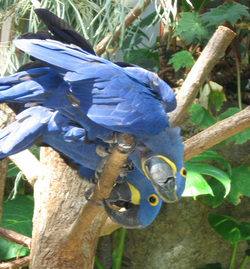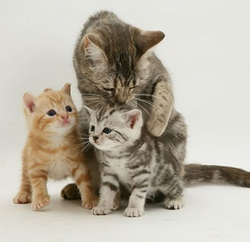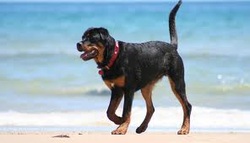 German Shepherd dogs have a rather mixed reputation. They are a large breed, and are often used as guard dogs or as attack dogs by the police. Their working roles have given them a reputation as a fierce dog, certainly not one to be messed with! Certainly, if you see an advert for a German Shepherd for sale you must make inquiries about its nature and its role in its current setting (has it ever been a working dog?). But there is another side to their nature and one that is well-known among German Shepherd enthusiasts: they can make incredibly loyal, friendly family pets. German Shepherd puppies are exuberant and playful like any other puppies, but their basic intelligence means that they are much easier than some puppies to train. Indeed, their intelligence and obedience is one of the main reasons they are chosen as a breed to work with the police. People who are interested in buying German Shepherd puppies generally search for a breeder. Breeders of German Shepherds are (or should be) very passionate about the breed as a loving pet, and should have taken great care to breed for temperament. You should be able to meet the mother and see the puppies in their normal home environment so that you can take a view about their personality, how well socialised they have been by the breeder and so on. If faced with a litter of German Shepherd puppies, it can be tempting to opt for the one who is most friendly and playful, the one that bounds up to you and makes a big fuss. But that type of dog might be more difficult to train than one who is rather less forthcoming. A puppy that clings to the mother and shrinks from human contact may also not make a suitable family pet if it is anxious or withdrawn. As with all pedigree dogs, German Shepherds can suffer from some genetic conditions (brought about through breeding for appearance that may be unnatural and cause physical deformity). If buying from a breeder, ask to see the mother’s records from the vet to see whether there are any conditions that the puppies might have inherited. An alternative to looking for a German Shepherd for sale is to make enquiries of an animal charity such as the RSPCA to see whether any of their rescue or rehoming centres has one available for adoption. Adopting a German Shepherd dog gives you less choice as to which dog you take home, but the staff at the centre will be able to give you an unbiased, honest summary of each dog’s personality and temperament. You can also be sure that a dog ready to be adopted will have been treated for parasites, vaccinated and micro-chipped. German Shepherds make really excellent family pets. All you need is a large space, plenty of time and energy to exercise them, and the ability to promise the dog a loving home for the rest of its life.
 Parrots are perhaps the most commonly-owned of all exotic pets in the UK, and they can give their owners a great deal of pleasure through their attractive colours and intelligent behaviour. But as with all exotic pets it is important to give the right pet care because giving them the wrong diet can make them very ill. Pet birds are frequently given up for adoption because their owners did not consider how much care and attention they would need before they bought them. If you’re thinking of buying or rehoming a pet bird, only do so if you believe that your parrot will have enough company and entertainment during the day: a bored or lonely parrot will become stressed and unhappy and will often pluck out their feathers. Also be sure to check your bird regularly for obvious signs of ill-health or mites, and get your bird seen by a specialist vet at the earliest opportunity if something seems amiss. It is a good idea to get pet insurance for your bird – there are specialist policies available for exotic pets that should cover birds, and the monthly premiums tend to be small (and certainly more than the cost of any vets’ bills). Different breeds of bird need different food to thrive. Parrots can become ill if they are not given a diet with all the nutrients they require, so take care to understand what they need before you buy. Parrots’ diets should include some seeds but seeds should not make up the bulk of their diet. Seeds are high in fat and lack certain vitamins and minerals that parrots need to be healthy. There are specialist parrot pellets available that offer all the vitamins and minerals that parrots need, because they are made from a variety of foodstuffs including fruit and vegetables. These are a better option than seeds alone, but parrots often grow bored of eating them and they should be offered fresh alternatives to supplement the pellets. Good vegetables to offer include dark green leafy veg like spinach and cabbage or broccoli. Offer these vegetables cooked or raw to see what your bird prefers. You can try other vegetables like carrots, green beans, peppers, corn or cucumber. They also enjoy fruit and get many of their vitamins and minerals from it. Good fruit to offer can include: kiwi, pineapple, berries, apples, grapes, peaches, bananas and oranges. Don’t let them eat the pith or seeds as these can be toxic. You can also offer your parrot pasta and brown rice (cooked). As parrots need plenty of calcium you should make sure that they always have access to a cuttlefish bone in their cage, which they will enjoy nibbling on. Never feed your parrot: avocado, apple seeds, chocolate, rhubarb or onions, and don’t give them any lactose products (like cheese).
 As pets go, a horse is pretty much at the top of most children’s wish list. A horse offers companionship and freedom to ride around independently and is lots of fun to be around. Of course, a horse is a powerful animal and proper supervision must be given at all times when allowing your child to ride or care for one. But if your child is properly supervised and learns how to ride properly as well as care properly for their horse, there are many benefits to your child of keeping a pet horse. For one thing, your child will quickly learn that they are responsible for caring for their horse and that that means getting up early every morning, feeding, mucking out, grooming, cleaning tack and picking out hooves – a pet horse isn’t just for riding. This sense of responsibility and duty will stand your child in good stead as they grow older, and the need for them to be up early to care for their horse each day (and the fact that they will want to spend all their time at the stables) will keep them out of trouble as they hit their teens! Whilst most sorts of pets live in the house and don’t take much looking after compared to a horse – so there’s no pet quite like a horse for getting your child out of the house and into the fresh air. Horse riding is aerobic exercise, great for keeping a child’s heart and lungs in top condition and good for reducing excess weight or maintaining a healthy weight. With fitness comes confidence, so your child will develop their sense of self and really come out of their shell. Horse riding also improves co-ordination, dexterity and balance – if your child has dyspraxia then it is a great hobby to get them interested in for that reason alone. If you are thinking of investing in a horse as a pet for your child, only do so if you can commit to caring for that horse for the rest of its life. Remember that the horse might still be alive and in need of looking after even after your child has moved out to go to university or to live independently. A horse also represents a huge financial commitment. Many horses are abandoned or taken to charities to care for because an owner cannot afford the time or money to continue to care for it. If you want a horse as a pet, consider rehoming one such horse and you’ll have a friend for life.
 If you own a cat (or cats), the chances are that you might never have to give them a bath, particularly if they have short hair or live indoors. But there are times when the need to bathe your cats cannot be avoided – for example, they might come home one night covered in some kind of mystery substance from who-knows-where, or they might have loose stools that get matted up in their fur near their tail (especially if they have long hair). If your cat needs a bath, then you can either take it to a local pet grooming service, though for many cats the stress of going in a cat carrier and in the car is greater than any stress that could be caused by being given a bath at home. And that’s your alternative, of course – to give your cat a bath at home. If you’re really well-prepared, then you will have given your cat or cats baths when they were kittens, to get them accustomed to being washed. Few people do this, though, so if you’re reading this having discovered something unknown or undesirable in your cats’ fur then you’ll be dealing with a cat that has never been wet other than through its own choice or by being caught out in the rain. Your cat will not be happy with you if you decide to give it a bath, but needs must. You’ll need cat shampoo (human shampoo will irritate their skin because it is too harsh), a big bowl of water (a bucket is normally too narrow) or sink filled with about four or five inches of warm (not hot) water and a towel spread out on the floor next to you. You’ll also be well advised to wear long sleeves that you don’t mind getting wet, and perhaps lightweight gardening gloves (you are going to get scratched). Finally, make sure your showerhead will reach the sink or bowl, or use a showerhead attachment that you can fit to the sink’s taps. Speak softly to your cat and make soothing sounds whilst you put it in the water. You may need a second person to help you as the cat will try to use their legs to stick to the sides of the sink/bowl rather than touch the water. If your cat likes treats, offer some and see if that will distract them – it might not. The key is to get this task done quickly and efficiently to minimise distress to your cat. Put a little bit of shampoo onto your cat’s body (either the bit that needs it or all over, depending on why you’re bathing your cat in the first place). Don’t put it on their head if you can avoid it – and if you must use it on your cat’s head then make sure it doesn’t go in its eyes or ears. Rinse the shampoo out with the showerhead (again, take care not to allow the shampoo to get in the cat’s eyes or ears), then remove your cat from the water and put it straight onto the towel. Wrap the towel around the cat to keep it in place and use it to gently rub the cat dry. If you have more than one cat and have for some reason had to bath both cats, never try to bath them together. Unfortunately the second cat will be harder to catch and bath because it will have seen what happened to the first cat and do everything in its power to avoid the same fate. After the cats have been bathed, they will smell different and they might fight. Use the same towel to dry both cats, and keep them separated until they have had chance to lick themselves properly. Don’t let your cats go outside until they are completely dry or they will be very uncomfortable. Finally, pour yourself a glass of wine, apply plasters where needed and fervently hope that you’ll never have to go through it all again.
 Taking pets (especially dogs) on holiday is now becoming more and more commonplace. There are many pet friendly cottages available throughout the UK, so if you’re planning on travelling in the UK this year there really is no need to leave your pet to be cared for at home, or to put your pet in a kennel or cattery. Whilst it is possible to travel abroad with your pet if they have a pet passport, most people find that taking their dogs on such a long journey is unfair or too much for their pet to handle comfortably, so they stick to holidays in the UK. Dog friendly cottages are very popular in places that attract walkers and ramblers, such as in the Yorkshire Dales, the Highlands, Cornwall and Devon, and Norfolk. However, it is important to act responsibly when taking your dog or other pet on holiday. Some holiday homes that have previously advertised themselves as ‘pet friendly cottages’ stop doing so because of the mess that has been left behind by irresponsible dog or pet owners. Pet friendly cottages can only continue to exist if they are treated with respect. Before you book with a pet friendly hotel, make sure you tell them what sort of pet (and/or how many pets) will be travelling with you and check that they will be happy to accommodate you. If you have several particularly large dogs, for example, you might find that the dog friendly cottage you had hoped for is rather reluctant to let you stay. It is better to book into somewhere that knows what to expect than to hide information and make things awkward later. You should be asked for proof that your pet is free from disease or parasites before your visit, so that any future pets are not infected – if you are not asked, then beware that whoever visited the cottage before you might have left behind some unwanted pests! If you are staying in a pet friendly cottage, don’t leave your pet behind when you go out because your pet could get up to all sorts of mischief (and may spend the day annoying the neighbours with barking or other noise). Make sure you clear up any mess left behind in the garden (or inside, of course!). Keep dogs on a lead when near other people and if you are travelling on public transport keep your pet close to you and contained in a suitable pet carrier. Make sure that whatever happens, you know that the people who have rented their cottage to you would be happy for you to return. If you act irresponsibly then you may make them decide not to accommodate any pets in future, which spoils it for everyone.
|





 RSS Feed
RSS Feed